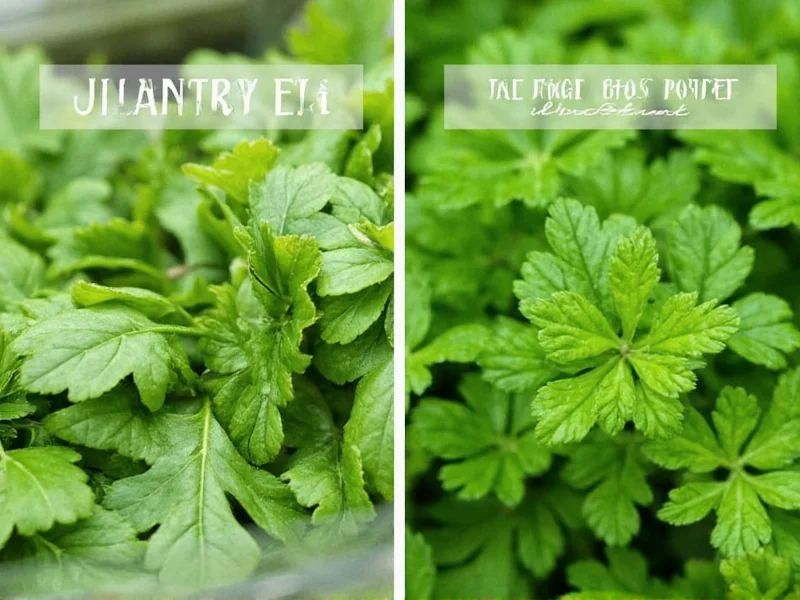When standing in the grocery store holding two nearly identical bunches of fresh herbs, many home cooks face the common dilemma: cilantro leaf vs parsley leaf. Despite their visual similarities, these herbs possess distinct characteristics that affect both identification and culinary use. Understanding the subtle yet critical differences between Coriandrum sativum (cilantro) and Petroselinum crispum (parsley) can transform your cooking experience and prevent recipe disasters.
Visual Identification: Spotting the Differences
Learning how to tell the difference between cilantro and parsley begins with close examination of their physical characteristics. While both grow in similar bunch formations with feather-like leaves, their structural details reveal clear distinctions.
| Characteristic | Cilantro Leaf | Parsley Leaf |
|---|---|---|
| Leaf Shape | Rounded with smooth, scalloped edges | Pointed with finely serrated edges |
| Leaf Texture | Softer, more delicate | Firmer, slightly tougher |
| Color | Bright medium green | Darker, richer green |
| Stem Attachment | Leaves grow directly from thin stems | Leaves grow from thicker, more prominent stems |
| Overall Appearance | More rounded, almost circular clusters | More angular, pointed clusters |
Flavor Profiles: Why Substitution Matters
The most significant difference between these herbs lies beneath the surface—in their flavor chemistry. Can I substitute parsley for cilantro successfully? Generally, no, and here's why:
Cilantro delivers a bold, citrusy punch with soapy undertones (for those with the OR6A2 gene variation) that's essential in Latin American, Indian, and Southeast Asian cuisines. Its volatile compounds break down quickly when heated, making it primarily a finishing herb.
Parsley offers a clean, grassy flavor with subtle bitter notes that withstand cooking better than cilantro. Italian (flat-leaf) parsley provides more robust flavor than curly parsley, which works better as a garnish. Chefs rely on parsley's versatility in European and Middle Eastern dishes where cilantro would create flavor dissonance.
Culinary Applications Compared
Understanding cilantro leaf shape vs parsley helps prevent culinary mistakes, but knowing their proper applications ensures recipe success:
- Cilantro's specialty: Salsas, guacamole, chutneys, Thai curries, Vietnamese pho, and as a fresh garnish for tacos and ceviche. Never cook cilantro extensively—it loses its distinctive flavor.
- Parsley's strength: Gremolata, tabbouleh, chimichurri, bouquet garni, and as both a cooking herb and garnish. Italian parsley withstands炖ing better in soups and stews.
When recipes call for one herb specifically, substitution usually compromises authenticity. The exception? In cooked dishes where appearance matters more than flavor (like garnishing), curly parsley can sometimes stand in for cilantro visually—but never vice versa in traditional cilantro-dependent recipes.
Nutritional Comparison
Both herbs offer impressive nutritional benefits, though with different emphases. A comparison of nutritional comparison of cilantro and parsley per 1/4 cup (15g) serving reveals:
- Cilantro: Higher in vitamin K (16% DV), contains significant amounts of vitamin A and potassium. Contains antioxidants like quercetin and terpinene that may support detoxification.
- Parsley: Exceptionally high in vitamin K (21% DV) and vitamin C (11% DV), with notable vitamin A and folate. Contains apigenin, a compound studied for potential anti-inflammatory effects.
While both contribute to a nutrient-dense diet, parsley generally provides more concentrated vitamins, whereas cilantro offers unique phytochemicals that support liver function according to preliminary research.
Growing Characteristics for Home Gardeners
For those interested in growing cilantro vs growing parsley, understanding their cultivation needs prevents garden disappointment:
- Cilantro: Grows quickly but bolts (goes to seed) rapidly in warm weather. Prefers cooler temperatures and partial shade. Harvest leaves when plants reach 6 inches tall. Seeds become coriander.
- Parsley: Slower to germinate but more cold-hardy. Tolerates partial shade to full sun. Italian parsley develops stronger flavor than curly varieties. Can overwinter in milder climates.
Gardeners often plant cilantro successionally every 2-3 weeks for continuous harvest, while parsley serves as a longer-term garden staple. Both require well-draining soil but cilantro needs more consistent moisture.
Common Identification Mistakes
Even experienced cooks sometimes confuse these herbs. The most frequent errors when trying to identifying cilantro and parsley leaves include:
- Mistaking young parsley for cilantro due to similar leaf size
- Confusing culantro (a different herb entirely with锯齿状 leaves) with cilantro
- Assuming color alone indicates the herb (both can appear similarly green)
- Not checking the stem structure, which provides the most reliable visual clue
The definitive test? Smell and taste. Cilantro delivers an immediate citrusy, sometimes soapy aroma, while parsley smells clean and grassy. When in doubt, crush a small leaf between your fingers—the scent difference becomes unmistakable.
Storage and Shelf Life
Proper storage extends the life of both herbs but requires slightly different approaches for fresh cilantro vs fresh parsley:
- Cilantro: Store stems in water (like flowers) with a loose plastic bag covering, refrigerated. Lasts 7-10 days. Freezing diminishes flavor significantly.
- Parsley: More durable—store in a damp paper towel inside a container or plastic bag. Lasts 10-14 days. Freezes well for cooking applications.
Revive wilted herbs by trimming stems and placing in ice water for 15-20 minutes. Cilantro recovers less reliably than parsley due to its more delicate structure.











 浙公网安备
33010002000092号
浙公网安备
33010002000092号 浙B2-20120091-4
浙B2-20120091-4